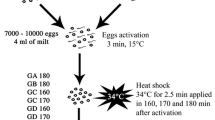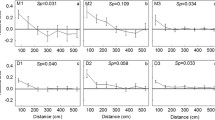Abstract
Employing recently developed culture methods, 21 colonies of the hermaphroditic bryozoan Celleporella hyalina (L.) established as primary zooids, were grown in isolation for 70 or 79 d before being placed in a communal location, to investigate the possibility of autogamy. Colonies grew rapidly, with compact circular form and a low perimeter:area ratio. Autozooids and sexual zooids were produced as normal. Five colonies produced embryos after 5wk, and only two colonies remained barren for the duration of the isolation period. Placement in communal location was accompanied by substantially increased larval output. In control colonies where isolation was prolonged, brooding activity remained low. Abortion was frequent, and settlement of the few larvae produced in isolation was never observed. It was concluded that although self-fertilisation may be available as an “emergency option”, C. hyalina is routinely outcrossing in nature. The frequent abortion and apparent absence of settlement in autogamous offspring suggest that these offspring may be of reduced fitness.
Similar content being viewed by others
Literature cited
allman, G. H. (1856). A monograph of the fresh-water Polyzoa, both British and foreign. Ray Society, London
Bell, G. (1982). The masterpiece of nature: the evolution and geneties of sexuality. University of California Press, Berkeley
Bishop, J. D. D., Ryland J. S. (1991). Storage of exogenous sperm by the compound ascidian Diplosoma listerianum. Mar. Biol. 108: 111–118
Braem, F. (1897). Die geschlechtliche Entwicklung von Plumatella fungosa. Biblphia zool. 10: 1–94
Cancino, J. M. (1983). Demography of animal modular colonies. PhD. thesis. University of Wales, Bangor
Cancino, J. M. (1986). Marine macroalgae as a substratum for sessile invertebrates: a study of Celleporella hyalina (Bryozoa) on fronds of Laminaria saccharina (Phaeophyta). Monogr. Biol. 4:279–308
Cancino, J. M., Castaneda, B., Orellana, M. C. (1991). Reproductive strategies in bryozoans: experimental test of the effects on conspecific neighbours. Bull. Soc. Sci. nat. Ouest Fr. Mém. HS 1: 81–88
Charlesworth, D., Charlesworth, B. (1987). Inbreeding depression and its evolutionary consequences. A. Rev. Ecol. Syst. 18: 237–268
Chimonides, P. J., Cook, P. L. (1981). Observations on living colonies of Selenaria (Bryozoa, Cheilostomata) 2. Cah. Biol. mar. 22: 207–219
Clark, W. C. (1978). Hermaphroditism as a reproductive strategy for metazoans; some correlated benefits. N.Z. JI Zool. 5: 769–780
Clark, W. C. (1981). Sperm transfer mechanisms: some correlates and consequences. N. Z. Jl Zool. 8: 49–65
Corrêa, D. D. (1948). A embriologia de Bugula flabellata (J. V. Thompson) (Bryozoa Ectoprocta). Bolm Fac. Filos. Ciênc. Univ. S Paulio (Zool.) 13: 7–71
Daly, J. M., Golding, D. W. (1977). A description of the spermatheca of Spirorbis spirorbis (L.) (Polychaeta: Serpulidae) and evidence for a novel model of sperm transmission. J. mar. biol. Ass. U. K. 57: 219–227
Dyrynda, P. E. J. (1981). Studies on marine Bryozoa. PhD. thesis. University of Wales, Swansea
Dyrynda, P. E. J., King, P. E. (1982). Sexual reproduction in Epistomia bursaria (Bryozoa: Cheilostomata), an endozooidal brooder without polypide recycling. J. Zool., Lond. 198: 337–352
Falconer, D. S. (1981). Introduction to quantitative genetics. Longman, London
Ghiselin, M. T. (1969). The evolution of hermaphroditism among animals. Q. Rev. Biol. 44: 189–208
Ghiselin, M. T. (1974). The economy of nature and the evolution of sex. University of California Press, Berkeley
Grosberg, R. K. (1987). Limited dispersal and proximity-dependent mating success in the colonial ascidian Botryllus schlosseri. Evolution 41: 372–384
Harvell, C. D., Grosberg, R. K. (1988). The timing of sexual maturity in clonal animals. Ecology 69: 1855–1864
Heath, D. J. (1977). Simultaneous hermaphroditism: cost and benefit. J. theor. Biol. 64: 363–373
Hincks, T. (1851). Notes on British zoophytes with descriptions of some new species. Ann. Mag. nat. Hist. (Ser. 2) 8: 253–263
Hughes, D. J. (1987). Gametogenesis and embryonic brooding in the cheilostome bryozoan Celleporella hyalina. J. Zool., Lond. 212: 691–711
Hughes, D. J. (1989). Variation in reproductive strategy among clones of the bryozoan Celleporella hyalina. Ecol. Monogr. 59: 387–403
Hughes, D. J. (1992). Genotype-environment interactions and relative clonal fitness in a marine bryozoan. J. Anim. Ecol. 61: 291–306
Hughes, R. N. (1989). A functional biology of clonal animals. Chapman & Hall, London and New York
Hughes, R. N., Cancino, J. M. (1985). An ecological overview of cloning in Metazoa. In: Jackson, J. B. C., Buss, L. W., Cook, R. E. (eds.) Population biology and evolution of clonal organisms. New Haven: Yale University Press, p. 153–186
Hunter, E., Hughes, R. N. (1991). Growth of laboratory cultured colonies of Celleporella hyalina (L.) Bull. Soc. Sci. nat. Ouest Fr. Mém. HS 1: 187–191
Huxley, T. H. (1856). Note on the reproductive organs of the cheilostome Polyzoa. Q. Jl microsc. Sci. 4: 191–192
Joliet, L. (1877). Contributions à l'histoire naturelle des Bryozoaires des côtes de France. Archs Zool. exp. gèn. 6: 1–122
Kahmann, D. (1984). Preliminary investigations of the genital system and the mode of sperm transfer in the sedentary polychaete Fabricia sabella (Sabellidae). Fortschr. Zool. 29: 289–292
Marcus, E. (1934). Uber Lophophus crystallinus (Pall.). Zool. Jb. 58: 501–606
Marcus, E. (1938). Bryozoarios marinhos Brasileiros. II. Boln Fac. Filos Ciênc. Univ. S Paulo (Zool.) 2: 1–196
Marcus, E. (1941). Sobre bryozoa do Brasil. Boln Fac. Filos. Ciênc. Univ. S Paulo (Zool.) 5: 3–208
Maturo, F. J. (1991). Self fertilisation in gymnolaemate Bryozoa. Bull. Soc. Sci. nat. Ouest Fr. Mém. HS1: p.S 72 (Abstr.)
Maynard-Smith, J. (1978). The evolution of sex. Cambridge University Press, Cambridge, England
Miller, R. L. (1982). Sperth chemotaxis in ascidians. Am. Zool. 22: 827–840
Moyano, H. I. (1986). Bryozoa marinos chilenos. VI. Cheilostomata Hippothoidae. South Eastern Pacific species. Boln Soc. Biol. Concepción 57: 89–135
Nicklas, N. L., Hoffman, R. J. (1981). Apomictic parthenogenesis in a hermaphroditic terrestrial slug, Deroceras laeve (Müller). Biol. Bull. mar. biol. Lab., Woods Hole 160: 123–135
Parker, G. A. (1970). Sperm competition and its evolutionary consequences in insects. Biol. Rev. 45: 525–567
Picard, A. (1980). Spermatogenesis and sperm-spermatheca relationships in Spirorbis spirorbis (L.). Int. J. Invert. Reprod. 2: 73–83
Robertson, A. (1903). Embryology and embryonic fission in Crisia. Univ. Calif. Publs. Zool. 1: 115–156
Ryland, J. S. (1973). The analysis of spatial distribution pattern. In: Larwood, G. P. (ed.) Living and fossil Bryozoa. Academic Press, London, p. 165–172
Ryland, J. S. (1976). Physiology and ecology of marine bryozoans. Adv. mar. Biol. 14: 285–443
Ryland, J. S., Bishop, J. D. D. (1990). Prevalence of cross-fertilisation in the hermaphroditic compound ascidian Diplosoma listerianum. Mar. Ecol. Prog. Ser. 61: 125–132
Ryland, J. S., Gordon, D. P. (1977). Some New Zealand and British species of Hippothoa (Bryozoa; Cheilostomata). Jl R. Soc. N.Z. 7: 17–49
Schopf, T. J. M. (1977). Population genetics of bryozoans. In: Woollacott, R. M., Zimmer, R. L. (eds.) Biology of bryozoans. Academic Press, London, p. 459–486
Shields, W. M. (1982). Philopatry, inbreeding and the evolution of sex. University of New York Press, Albany
Silén, L. (1966). On the fertilisation problem in the gymnolaematous Bryozoa. Ophelia 3: 113–140
Silén, L. (1972). Fertilisation in the Bryozoa. Ophelia 10: 27–34
Thorpe, J. P., Beardmore, J. A. (1981). Genetic variation in natural populations of marine bryozoans. In: Larwood, G. P., Nielsen, C. (eds.) Recent and fossil Bryozoa. Olsen & Olsen, Fredensborg, Denmark, p. 263–272
Ward, S., Carrel, J. S. (1979). Fertilisation and sperm competition in the nematode Caenorhabditis elegans. Devl Biol. 73: 304–321
Williams, G. C. (1975). Sex and evolution. Princeton University Press, Princeton
Author information
Authors and Affiliations
Additional information
Communicated by J. Mauchline, Oban
Rights and permissions
About this article
Cite this article
Hunter, E., Hughes, R.N. Self-fertilisation in Celleporella hyalina . Marine Biology 115, 495–500 (1993). https://doi.org/10.1007/BF00349848
Received:
Accepted:
Issue Date:
DOI: https://doi.org/10.1007/BF00349848




